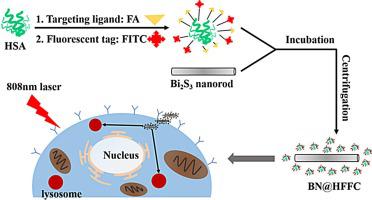Colloids and Surfaces B: Biointerfaces ( IF 5.8 ) Pub Date : 2020-07-29 , DOI: 10.1016/j.colsurfb.2020.111291 Shouning Yang 1 , Yanmin Zhang 1 , Sijia Lu 1 , Lihong Liu 1 , Lin Yang 1 , Yuming Guo 1 , Shaoning Yu 2 , Huayan Yang 1

|
One of the main diseases contributing to human death are malignant tumors. Phototherapy is a promising approach for cancer therapy, and functional nanoparticles with targeting ligands are commonly used to improve the therapeutic efficiency. However, recent studies have shown that nanoparticles in contact with a biological fluid can rapidly form a “protein corona” on their surface, which will remarkably decrease the targeting ability. Here, we describe the preparation of hybrid nanomaterials with Bi2S3 nanorods as the core, and fluorescein-isothiocyanate and folic acid-modified human serum albumin (HSA-FITC-FA) as the shell. By using fluorescent binding label (FITC) and imaging techniques, we discovered the image of the cell lysosomes, indicating that the photothermal therapy agent was predominantly targeted to and accumulated in lysosomes. Combined with photothermal therapy agent (Bi2S3 nanorods) and targeting ligand (FA), the obtained product shows enhanced photothermal therapy under near-infrared region laser irradiation. Additionally, SDS-PAGE shows that the modified HSA shell could remarkably reduce the reabsorption of protein corona from blood serum, minimized the adverse effect of protein corona on targetability. Taken together, the results indicate that our strategy has the potential for preparing efficient photothermal nanomaterials with image-guided subcellular organelle-targeting cancer cell ablation ability.
中文翻译:

靶向溶酶体的标记蛋白电晕涂层Bi2S3纳米棒用于生物成像和有效的光热癌症治疗。
导致人类死亡的主要疾病之一是恶性肿瘤。光疗法是用于癌症疗法的有前途的方法,并且具有靶向配体的功能性纳米粒子通常用于提高治疗效率。但是,最近的研究表明,与生物流体接触的纳米颗粒可以在其表面上迅速形成“蛋白电晕”,这将显着降低靶向能力。在这里,我们描述了Bi 2 S 3杂化纳米材料的制备以纳米棒为核心,以异硫氰酸荧光素和叶酸修饰的人血清白蛋白(HSA-FITC-FA)为外壳。通过使用荧光结合标记(FITC)和成像技术,我们发现了细胞溶酶体的图像,表明光热治疗剂主要靶向并累积在溶酶体中。与光热治疗剂(Bi 2 S 3纳米棒和靶向配体(FA),所得产品在近红外区激光辐照下显示出增强的光热疗法。另外,SDS-PAGE表明,修饰的HSA壳可以显着降低血清中蛋白质电晕的重吸收,使蛋白质电晕对靶向性的不利影响最小。两者合计,结果表明我们的策略具有制备具有图像引导的靶向亚细胞细胞器癌细胞消融能力的有效光热纳米材料的潜力。



























 京公网安备 11010802027423号
京公网安备 11010802027423号